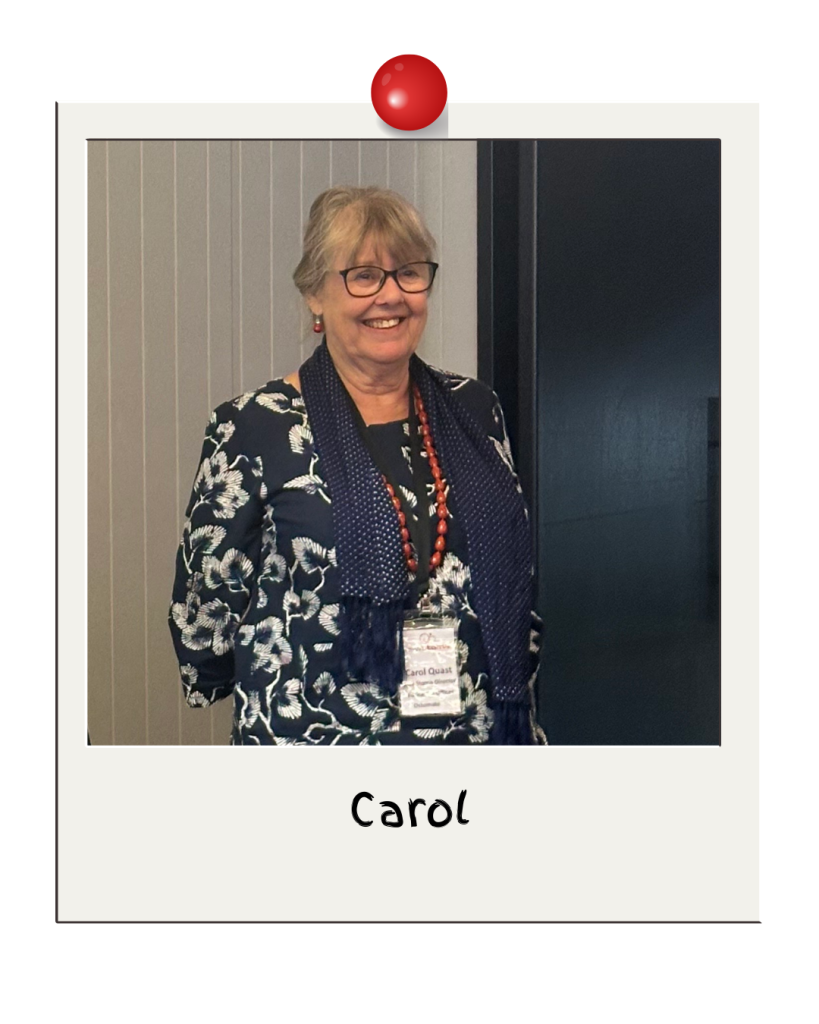
Carol's story
Carol Quast is a mother, wife, teacher, and creative. Happily married (“for 44 years!”) with three adult sons, she is an accomplished educator who enjoys creative writing and travel. She is also an ostomate and is NSW Stoma’s Education Officer and former Director of the Board, having served from 2016 to 2025. If she looks familiar, that’s probably because she helps facilitate our monthly Members Zoom meetings and the combined Ostomy NSW and NSW Stoma’s Stomal Therapy Education Days.
Since February 2012 Carol has had a permanent colostomy, and since 2018 she has self-catharised five times a day. This means Carol manages her stoma through a process known as colostomy irrigation, which you will learn more about in this article.
Carol’s #stomastory began in December 2011 when she arrived back in Australia after 20-odd years living in the U.K. Perhaps somewhat ominously, waiting for her at home was a bowel cancer testing kit.

Carol and her son at his university graduation in the U.K.
“Not thinking much of it, I sent it off and, unfortunately, the results came back positive,” Carol says.
In January 2012, she was sent off for a CT scan and a colonoscopy; the results of which showed Carol had a malignant rectal tumour (bowel cancer).
In February, at St. Vincent’s Public Hospital in Sydney, she had her permanent stoma created: an operation consisting of an abdominal resection and the surgical creation of a colostomy.
In what would be a life-altering event for anyone, in hospital Carol credits the support of her stoma nurses with aiding in her recovery with their expertise covering general care, using stoma appliances, supporting her generally, and “answering her never-ending questions!”
Despite the fantastic support she received, after her surgery and into her recovery, Carol understandably felt overwhelmed, alone, and confused.
Nevertheless, just three weeks after her operation, Carol proceeded with an ambitious trip to Canberra with family; explaining she took it easy – “with lots of nanna naps!” – she was even able to make it to the theatre!

Carol and a friend attending the theatre only weeks after her stoma surgery
A writer by nature, Carol started a diary to journal her stoma recovery experience. She credits this with helping her understand her new life and being able to identify any common factors in trying to understand her stoma.
Like many, Carol also searched for information online, finding some websites helpful, and others, “not so much”.
A turning point came in March 2012 when she made an appointment to see Anne Marie Lyons, stoma nurse at NSW Stoma, where she was able to seek help and learn about her options.
“Not only did she listen, Anne Marie helped me physically, giving me advice on how to deal with the red and angry skin around my stoma.”
Anne Marie also proposed what would soon become a huge game changer for Carol: “She suggested I consider colostomy irrigation.”
Colostomy irrigation is a way to manage bowel movements by emptying the colon at a scheduled time. Similar to an enema, it involves putting water into the colon through the stoma, causing the bowel to empty.
“By repeating this process regularly, you can train your colon to empty without spilling waste in between irrigation,” Carol explains. “It can also help avoid constipation.”
“Anne Marie taught me the process of irrigation at the NSW Stoma clinic,” Carol adds, explaining how, at first, she irrigated every morning, and later, after another consultation with Anne Marie, every second day. This gave her more success and “more freedom!”
When it comes to ‘should you, or could you?’ for colostomy irrigation, Carol notes it’s worth remembering this is entirely a personal decision.
“If you’re a candidate, your stoma nurse who is specially trained in colostomy irrigation can train you for colostomy irrigation.”
When it comes to the why, Carol notes many benefits she’s had since irrigating, such as:
- A more normalised lifestyle
- Less embarrassing moments
- Training your bowel to evacuate when you want it to
- Using less appliances
- A sense of security and having control
- More freedom, including the freedom to travel; as you’re liberated by a lack of output between irrigation days

Carol on holiday
Soon after learning to irrigate, Carol was able to enjoy this freedom and ability to travel more – in May 2012, irrigating every second day, she enjoyed a spectacular trip to Bali, only three months after her big operation. And just four and a half months after her surgery, she flew to Europe for four weeks, where she joined her mother at her eldest son’s university graduation in Canterbury, Kent, U.K.; a wonderful time and memory made possible not only by her life-saving stoma surgery, but by her life-permitting colostomy irrigation process.
Now, in 2025, it’s been 13 years since her stoma surgery and Carol is living life to the fullest.
“I catch up with family and friends on a regular basis and travel as much as I can, both domestically and internationally.”
A seasoned traveller, Carol has some handy hints for other jetsetters with a stoma:
- Take all your irrigation gear (plus extra supplies) on-board with you in your carry-on luggage
- Plan ahead: including your travel dates, places, and the days your irrigation falls (change days if need be)
- When in overseas hotels or other accommodation options, always ensure you use potable water (drinking water) for your irrigation purposes; take a portable kettle if none are provided in your accommodation
- Take a selection of hooks to cater for as many bathroom layouts and situations as possible
Along with an active personal life, Carol keeps busy through her part-time work at the Story Factory in Sydney – a not-for-profit charity that facilitates creative writing workshops for marganalised young people aged 7 to 17.
And that’s all while volunteering her time at NSW Stoma, a former Director of the Board and our current Education Officer, a role which includes presenting at our monthly members’ Zoom meetings (this is where you may recognise her from!).
Along with her great practical advice, Carol wishes to remind all ostomates acceptance is key.

A positive mindset is crucial to accepting your new life with a stoma, Carol says. Pictured is a heart-shaped island as spotted and photographed while on a plane on holiday.
“Remember to stay positive,” she says. “Seek and accept support, be organised, and most importantly, believe ‘I can do this!’”
Conceding there will always be embarrassing moments, Carol makes the point, “but aren’t there in life anyway?” By being as prepared as possible, she says, it can help us deal with those moments. “Remember to laugh and embrace the positive times.”
In terms of what all new (and long-term) stoma patients need, Carol says support and understanding from family, friends, and medical staff is paramount.
“I knew I couldn’t change the outcome,” Carol says, “so over time, I learnt to accept and make the best of the situation.”
Highlighting the importance of seeking help when it’s needed, Carol says there are many great sources of information and support, including:
- Stomal therapy nurses (STNs)
- Stoma associations (such as NSW Stoma)
- Ostomy support groups, including NSW Stoma’s members’ Zoom meetings (held online monthly)
- Other stoma patients
- The Stoma Association’s Education Days
- Local hospitals
- Stoma and related websites
Still, according to Carol, the key to getting on with life with a stoma comes from the power within and is all to do with having a positive mindset.
“My personal mantras are: one step at a time, don’t overthink, and try to see the positive in all situations.”
October 2025




